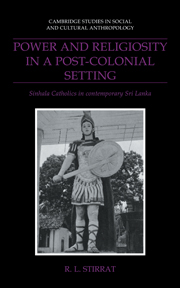Book contents
- Frontmatter
- Contents
- List of maps and figures
- List of tables
- Acknowledgements
- List of abbreviations
- Glossary
- Map 1 Sri Lanka
- Map 2 The west coast of Sri Lanka
- 1 Introduction
- 2 The colonial Church
- 3 The Church in crisis
- 4 The rise of Kudagama
- 5 Demonic possession and the battle against evil
- 6 Suffering and sacrifice
- 7 Holy men and power
- 8 Patronage and religion
- 9 On the borders
- 10 Conclusion
- Notes
- List of references
- Index
- Cambridge Studies in Social and Cultural Anthropology
5 - Demonic possession and the battle against evil
Published online by Cambridge University Press: 02 December 2009
- Frontmatter
- Contents
- List of maps and figures
- List of tables
- Acknowledgements
- List of abbreviations
- Glossary
- Map 1 Sri Lanka
- Map 2 The west coast of Sri Lanka
- 1 Introduction
- 2 The colonial Church
- 3 The Church in crisis
- 4 The rise of Kudagama
- 5 Demonic possession and the battle against evil
- 6 Suffering and sacrifice
- 7 Holy men and power
- 8 Patronage and religion
- 9 On the borders
- 10 Conclusion
- Notes
- List of references
- Index
- Cambridge Studies in Social and Cultural Anthropology
Summary
The centrality of demonic possession
All that I was told about Kudagama when I first heard of it in 1974 was that hundreds of demonically possessed people were going there every week to be cured. Throughout the seventies and eighties, the first thing that anyone would say about the shrine was that it was famous for the treatment of the demonically possessed. Those who supported the shrine saw the treatment of the possessed as proof of the sacredness of the shrine whilst those who were opposed to such forms of religiosity saw the incidence of possession as evidence that the shrine was founded on a major error concerning the nature of religion, and that it was no more than a manifestation of ‘superstition’.
In a very real sense the legitimacy of the shrine and the claims made by and for Father Jayamanne depended upon curing the demonically possessed. The ranting, raving, screaming, rolling in the mud and speaking in strange tongues of the demonically possessed were taken as proof that the shrine was a sacred place, a hierophany, where divine power was immanent. Because of this, devotees came for other reasons: for jobs, for health, for money, for legal assistance or just for divine grace. The shrine of Kudagama grew on the backs of the demonically possessed and depended upon them for its existence. Only as long as shrines such as Kudagama could provide a visible and audible display of the battle between the forces of good and evil could they prosper, but shrines declined as soon as they failed to supply such visible proof.
Information
- Type
- Chapter
- Information
- Power and Religiosity in a Post-Colonial SettingSinhala Catholics in Contemporary Sri Lanka, pp. 78 - 98Publisher: Cambridge University PressPrint publication year: 1992
